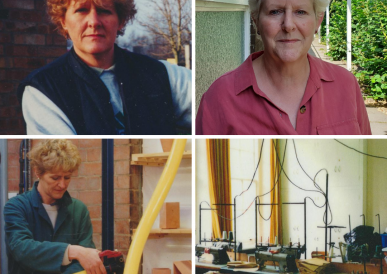Cheryl Roy is a Service Manager at Workbridge, covering WWASP (Workbridge Work and Social Programme), Light and Heavy Industry and Creative Garage, our introductory departments for patients at St Andrew's Healthcare. Cheryl has been with the charity for 36 years. Who better to ask about their memories of Workbridge over 40 years!
Cheryl's highlights at Workbridge:
I used to help organise a garden party every year (fete style) for patients. The whole hospital was involved. Every ward. We had a little budget for patients to do decorative arrangements. Upstairs there was photos of their displays. We used to spread the competition across wards and get everyone involved in some way – growing, creative writing, pictures.
We used to take 30 patients to the Cotswolds on a coach, having tea in a lovely village setting. The hosts were so fabulous with our patients, chatting to them and for me it was a real pleasure to experience and do usual things for the day outside of the hospital.
We helped a particular patient who didn’t believe in themselves, with low self-esteem and a learning disability, gain confidence. They used to stutter when they became anxious. They made it to Workbridge from WWASP and after two years of being there, they thrived on the work and it helped them gain confidence.
I started as a technical instructor at St Andrew’s Healthcare in 1984. I was working in the Industrial Therapy Unit, now known as WWASP (Workbridge Work and Social Programme), run by occupational therapy at St Andrew’s Healthcare.
Workbridge had been set up a few years earlier and we worked closely together.
St Andrew’s social worker Dorothy Davidson along with several other members of staff became involved in the concept of Workbridge because of their desire to expand and offer a Workbridge pathway to more people – through work experience.
The industrial therapy unit was highly valued because research at the time showed patients recovered when people were engaged in something meaningful and had a purpose. My department was a social place for people to meet. You got to work alongside others who had similar or vastly different needs to yourself and it brought people together and made them feel part of something bigger. This was the thing that drew me to this kind of work.
At the time we used to do lots of contracting work, so such things as picking, packing and assembly. Each task was broken down so that everyone could be part of it. Everything had a meaning and everybody contributed.
These skills were transferrable to everyday life. Patients felt valued and proud of the work they were doing as part of the wider team. I recall a patient with a brain injury who also had a residual limb. They would get frustrated with the work, and we used to help them by breaking down tasks. We made a gadget to enable them to do the same work and feel part of what we were doing. Nobody was excluded.
We’d have up to 16 patients in WWASP at any one time. We used to have a separate session for older people in the room next door. In this department, we had a record player and we used to play songs from old musicals and war time songs, and the patients loved it and would sing along to them.
I recall a time (when smoking was acceptable indoors) where one of the older patients accidentally dropped a cigarette into their handbag. It was full of tissues. You can imagine what could have happened… Well we put the smoke out before there was a serious issue by dunking the handbag in a sink of water, but the patient was furious with us. We’d ruined their nice handbag by running water over it. They hadn’t realised the handbag had been on fire, only the heartbreak of seeing their favourite handbag submerged in water.

I moved from the Industrial Therapy Unit to Workbridge in the nineties. My job was to look after the pathway from WWASP to Workbridge departments, making sure patients were comfortable and could buddy up with others and have a familiar face to talk to. I enjoyed that.
I was then asked to set up a horticulture department at Workbridge. Our founder, Michael Jones wanted somewhere on site for people to grow things and be involved in horticulture in some way. I worked with my husband Terry who was also at Workbridge and together we set up horticulture – both patient sessions and the commercial garden centre you know today. This was in the nineties. I’d always been keenly enthused by gardening and belonged to the horticulture therapy group at St Andrew’s Healthcare in the eighties and nineties.
I became the service manager for Horticulture, then Ceramics before returning to WWASP, as it is now called, to help patients from the beginning of their recovery onto the pathway to Workbridge and into the community again. In 2009, Workbridge merged with the wider charity of St Andrew’s Healthcare.
I have enjoyed being part of, and watching Workbridge grow from porta cabins to a wide array of departments and retail outlets. There is a marvellous Coffee Shop and Ceramics Studio now, and what was once waste ground, is now a lovely Garden Centre. The Braye Centre next door is also home to Workbridge Design & Print, a working canteen, Textiles, Office Skills, Contracting, Employment Support and a fabulously busy Woodwork department. It is a fantastic place to be.